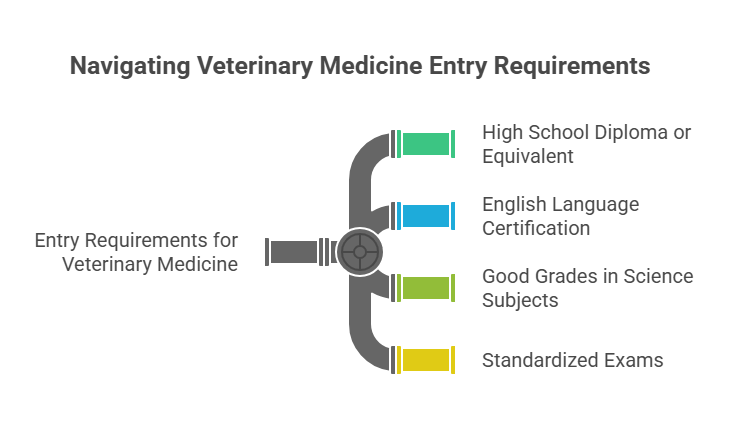How to Become a Veterinarian (DVM) & How Long is Vet School

Studying veterinary medicine is a dream career for many students, but figuring out how to start can feel overwhelming.
In this blog, we will clearly explain everything you need to know about becoming a veterinarian (DVM) and how long vet school is, including what the path looks like and how many years vet school takes, depending on the country.
The key takeaways of this blog include:
- Many European universities offer direct entry to veterinary school after high school, saving time and money
- European veterinary programmes typically last 5.5 to 6 years and are taught in English
- Studying veterinary medicine in Europe offers benefits such as lower tuition fees, recognised degrees, and a strong international community
- Medlink Students offers comprehensive support for aspiring veterinarians, from application to relocation and beyond graduation
- A European veterinary degree allows you to be licensed anywhere in Europe and beyond
Table of Contents
- 1 What Does It Take to Become a Veterinarian?
- 2 What Are the Entry Requirements for Veterinary Medicine?
- 3 How Long is Vet School?
- 4 Why Study Veterinary Medicine in Europe?
- 5 The Top European Veterinary Medicine Universities
- 6 Medlink Students' 1st-Year Entry Support For Aspiring Veterinarians
- 7 Licensing: Will My Degree Be Recognised?
- 8 Real Student Insights
- 9 Why This Matters to You
- 10 Ready to Join Veterinary School and Become a DVM?
- 11 FAQs
- 11.1 What Qualifications Do I Need to Be a Vet?
- 11.2 How Long Does It Take to Be a Veterinarian Abroad?
- 11.3 Is my veterinary degree from Europe recognised in the UK or the US?
- 11.4 How Much Do Vet Schools Cost in Europe?
- 11.5 Can Medlink Students Help Me Apply to Veterinary School?
- 11.6 Are Clinical Rotations Included in the Veterinary Degree?
What Does It Take to Become a Veterinarian?
Veterinary medicine is just as rigorous as human medicine, requiring years of education, clinical training, and licensing. However, it simultaneously brings on an incredible career where your love for animals makes a real difference. To become a fully licensed veterinary doctor or DVM, you'll typically follow this path:
- Apply to an accredited and internationally recognised veterinary medicine degree programme
- Complete 5.5 to 6 years of university-level veterinary education, including clinical rotations
- Graduate with a Doctor of Veterinary Medicine (DVM) or equivalent degree
In contrast to the United States and Canada, where applicants must first finish a 4-year bachelor's degree as a prerequisite, many European universities permit students to start studying veterinary medicine right out of high school.
Want to find out if veterinary medicine or human medicine is the right path for you? Check out our comparison blog.
What Are the Entry Requirements for Veterinary Medicine?
Most English-taught veterinary programmes in Europe require:
- High School Diploma or Equivalent (e.g. A-levels, IB, Abitur, Baccalauréat)
- English language certification, which could either be IELTS (typically 6.0–6.5) or TOEFL (80–90+ iBT). Some universities also accept proof of prior education in English instead.
- Good grades in biology, chemistry, and sometimes math or physics. Some may use standardised exams like BMAT, IMAT, or custom internal exams.
If you're unsure if you meet the entry requirements, book a free consultation with Medlink Students by filling the below form. Our expert advisors will review your qualifications and help you get accepted into the right vet school abroad.
Check your email to Book a FREE call
with an expert advisor
Look at your promotions/spam folders, just in case.


How Long is Vet School?
The duration of veterinary medicine school programmes depends on the country and university system; here's a quick comparison:
United Kingdom
Super competitive, with only about 10 universities offering courses. It's a 5-6 year programme taught in English, and you'll need A-levels in science to apply through UCAS.
Lithuania
A 6-year programme that is fully taught in English and really welcoming to international students. Entry isn't too harsh; All you need is an entrance exam, good school grades and an English certificate.
Hungary
Another 6-year option is taught in English. This option really focuses on practical experience, with around 1,800 hours of clinical training.
Poland, Slovakia & Bulgaria
Cities like Wrocław and Warsaw offer excellent veterinary medicine programmes in Poland in English, and Trakia University has an exceptional vet programme in Bulgaria. Poland and Bulgaria offer 5.5-year programmes (11 semesters), while Slovakia (Kosice) is 6 years.
So on average, veterinary science in Europe takes between 5.5 and 6 years, which includes both preclinical and clinical training. We at Medlink can help you find what suits you best in this case by booking a free consultation today, or you can check out all our English-taught veterinary programmes in Europe.
Why Study Veterinary Medicine in Europe?
Studying veterinary medicine in Europe offers several significant advantages:
- Direct entry from high school into vet courses, especially considering that in the US/Canada, students have to go through 4 years of pre-vet
- Lower tuition fees, which are typically around €12,500 a year, with living costs of around €300-€600 a month
- Courses are taught entirely in English
- Recognised vet degree in the UK, EU, and beyond
- No need for a separate undergraduate degree
- Advanced teaching hospitals and clinical exposures
The Top European Veterinary Medicine Universities
The top choices for universities to study veterinary medicine include:
1. Lithuanian University Of Health Sciences (LSMU)
Location: Kaunas, Lithuania
Programme length: 6 years
Tuition fees: €8,000 for years 1-3, €9,200 for year 4 and €10,000 for years 5-6
Language: English


If you're looking for a veterinary degree or DVM Programme that combines excellence, affordability, and career recognition, the Lithuanian University of Health Sciences, or LSMU, in Kaunas, Lithuania, offers a 6-year integrated master's in veterinary medicine. It offers a modern campus, hands-on clinical training, and full EAEVE accreditation. Taught entirely in English, LSMU prepares future vets to lead with confidence from day 1.
Programme Structure:
Vet courses in the programme include:
Years 1-2: Anatomy, histology, biochemistry and physiology
Years 3-4: Pathology, pharmacology, surgery, animal reproduction
Years 5-6: Clinical rotations, veterinary public health, food safety, thesis
Learn more about how to become a veterinarian at LSMU
2. University of Veterinary Medicine, Budapest
Location: Budapest, Hungary
Programme length: 5.5 years
Tuition fees: €12,500/year
Language: English


The University of Veterinary Medicine in Budapest is one of Europe’s oldest and most prestigious veterinary schools, offering a 5.5-year English-taught Doctor of Veterinary Medicine degree. It features modern facilities, intensive clinical training, and a diverse, multicultural student body. It is especially popular among UK and EU students. The university’s vet degree is accredited by EAEVE, ensuring recognition across EU member states and beyond. Its AVMA accreditation is also currently underway; once achieved, graduates will find it easier to pursue licensing in the USA and Canada.
Learn more about how to become a veterinarian at the University of Budapest, Hungary
Get expert advice from Medlink Students on applying to LSMU or the University of Veterinary Medicine in Budapest; book a free consultation today. You can also explore our list of other veterinary universities in Europe.
Medlink Students' 1st-Year Entry Support For Aspiring Veterinarians
Medlink Students provides expert guidance to help you:
- Apply to a top European vet medicine university with no delays
- Prepare for any required entry exams or interviews
- Fully support you in your visa applications, accommodation needs and relocation
- Ensure your degree will be recognised in your home country
From choosing the right school to submitting documents and arranging your move abroad, Medlink supports you every step of the way. Book your free consultation now and let us help you start your journey in your veterinary degree.
Licensing: Will My Degree Be Recognised?
If you plan to return to the UK, EU, or USA, you need to understand how recognition works:
UK
Graduates from the EU-accredited schools (like LSMU or Budapest) can register with the Royal College of Veterinary Surgeons (RCVS).
Europe
Degrees are automatically recognised from EU-accredited institutions.
USA/Canada
Students must complete the ECFVG or PAVE process, including passing the NAVLE licensing exam.
No matter where you plan to practice, a European veterinary degree allows you to be licensed anywhere as long as your chosen school is both reputable and accredited.
We understand the process may seem complex, so let Medlink Students' expert advisors guide you on the licensing and registration processes based on your target country.
Real Student Insights
Students often report easier access to veterinary programmes abroad compared to the limited seats available in vet schools in the UK. For example, the RVC receives more than 1900 applications each year for approximately 250 places.
They also report significant savings on tuition fees and living costs while maintaining high-quality education and training. Veterinary tuition in Europe can start as low as €8,950 per year.It's also important to highlight that these universities support a very strong international community and that international students have been flocking to study medicine in Europe due to their combination of value, speed, and recognition.
Why This Matters to You
Vet schools are more competitive than ever. In the UK alone, only around 1 student out of 10 gets accepted into the Royal Veterinary College.
This means 1000s of passionate, qualified students will be rejected, not because they’re not capable, but because there simply aren’t enough seats.
At the same time, the global shortage of veterinarians is reaching critical levels. Between 2019 and 2021, the number of vets joining the UK workforce dropped by 68%, from 1,132 to just 365. This means demand is growing, but spots are limited.
If you want to be a vet, studying abroad lets you do it without the high competition or huge costs. Many European universities offer English-taught DVM degrees that are recognised everywhere, often with easier entry and lower fees.
Ready to Join Veterinary School and Become a DVM?
Once you’ve decided to study veterinary medicine abroad, the next step is making sure you do it right. That’s where Medlink Students comes in.
Our Student Success Programme offers support from A to Z in your application, documents, exams, and relocation, guaranteeing that you’re on the right track to studying veterinary medicine abroad.Book a free consultation with Medlink Students today and get expert guidance from day one.
FAQs
What Qualifications Do I Need to Be a Vet?
You'll need a high school diploma with good grades in biology and chemistry, and proof of English proficiency. Some universities may also require an entrance exam or interview.
How Long Does It Take to Be a Veterinarian Abroad?
How long to become a veterinarian (DVM) in Europe typically takes 5.5 to 6 years. This includes both academic study and hands-on clinical training. Students may also need to complete licensing exams, depending on where they plan to practice.
Is my veterinary degree from Europe recognised in the UK or the US?
Yes, as long as you graduate from an EU-accredited and internationally recognised university, your degree can be validated in the UK, US, Canada, and beyond. Medlink students only work with fully recognised universities. You can read more about your veterinary school options on our website.
How Much Do Vet Schools Cost in Europe?
A vet degree abroad often costs less than in the UK or the US. For example, LSMU charges around €8,000 for years 1-3, €9,200 for year 4, and €10,000 for years 5-6.
Can Medlink Students Help Me Apply to Veterinary School?
Yes. Medlink Students provides full application support, including matching you with the best veterinary university for your goals, handling paperwork and entrance exams, and meeting your accommodation needs. We also offer ongoing guidance even after you start your studies. Start your search for vet med universities, and let us help you step by step with how to become a veterinarian by requesting a free consultation today.
Are Clinical Rotations Included in the Veterinary Degree?
Yes, European vet schools, like those in the UK, integrate clinical training throughout the curriculum. This is done in accordance with EU Directive 2005/36/EC, which requires vet schools to include at least 6 months of full-time clinical training. Students gain hands-on experience in simulation centres, hospitals, small, large and exotic animal clinics, research centres, farms, and more.
Leave a Reply


About Medlink Students
Leading international recruitment company for medical students in Europe. British Council Certified Agents. 10+ years of experience and more than 10,000 students advised.








